After having our hands on the Lenovo IdeaPad Yoga 11S Ultrabook convertible for a few weeks, we’re ready to bring you the full review. Is this 11.6-inch convertible with Intel’s Ivy Bridge Y-series processor right for you? Step inside to see our analysis.
Introduction
The Lenovo Yoga 11S is unique because it’s one of the only Ultrabooks on the market using Intel’s Y-series Ivy Bridge processor. Other Ultrabooks use U series processors which have a 17W Thermal Design Power (TDP). The Y-series processors have a 13W TDP which means they put out less heat — if at the same frequency as a U series processor, this generally means that they are more efficient. The Y-series processors also have a secondary heat spec called Scenario Design Power (SDP), which is listed at 7W.
In our Lenovo 11S first impressions article, there was some interesting conversation in the comments regarding the purpose of SDP on the Y-series processors. This is Intel’s official line on the matter:
The Mobile Y-processors have multiple design points providing maximum design flexibility for our customers to continue to push the envelope in terms of form factor innovation. The TDP of the Y-processors is 13W which is a 24 percent reduction from TDP of our lowest 3rd gen Intel Core processors today. In addition to the TDP reduction, the Y-processors also have an additional thermal reference point, namely scenario design power (SDP), which provides a balance of performance vs. design power for mainstream touch-first usages and operates at 7W.
– Source: CNET
Note that “customers” above is referring to the companies actually purchasing the processors, not the end-user.
As someone who doesn’t design computers for a living, all it means to me and the rest of the mainstream is that a Y-series processor could provide better battery life, assuming the engineers have designed to the SDP. Y-series could work well with Windows 8 by running at SDP levels while using the Metro/touch interface then being able to kick up the power while using traditional desktop.
Hardware
Lenovo Yoga 11S Specs
- Intel Core i7-3689Y Ivy Bridge processor (technical details)
- 11.6-inch IPS touchscreen @ 1366×768
- 256GB SSD
- 8GB of RAM
- Windows 8
- Ports: 1x USB 3.0, 1x USB 2.0, full HDMI, full SD, 3.5mm headphone/mic combo, volume rocker, rotate-lock
- Weight: 1.4kg
- Thickness: 17mm
Design
The Yoga 11S uses that same patented hinge that’s found on the larger Yoga 13. The trick to this convertible is that the screen flips all the way around backwards until it’s flat on the back of the Ultrabook, forming a tablet with a keyboard for a back.
The soft plastic that makes up the outer body of the Yoga 11S feels distinctly nicer than the plastic I’m used to feeling on computers. The textured soft plastic on the keyboard deck is the same — it feels different and decidedly more elegant than hard plastic.
Straight edges edges of the unit all the way around, with contrasting lid and edge colors, give the Lenovo Yoga 11S a classy portfolio / board room look. However, the non-tapering edges lack the ‘wow this is thin!’ factor (afforded to an Ultrabook like the Asus UX31), despite the 11S being about the same thickness (17mm).
The build quality is great all around, with my only concern being in some unwanted flex toward the middle of the keyboard — a common trend among Lenovo Ultrabooks that we’ve tested — but by no means a deal-breaker.
The optional ‘slot-in’ case holds the unit nicely when it’s closed. It’s also suppose to double as a cover over the keyboard when you flip to tablet mode, but it just doesn’t feel quite right (because it’s only on half of the unit).
Continue reading on page 2…

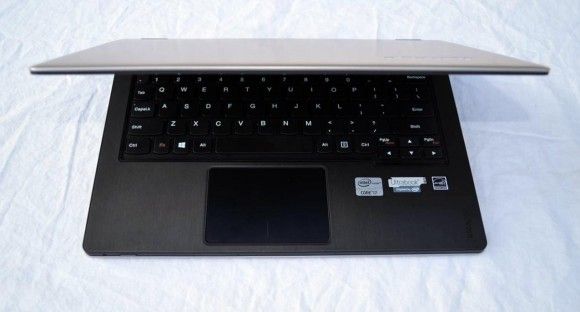
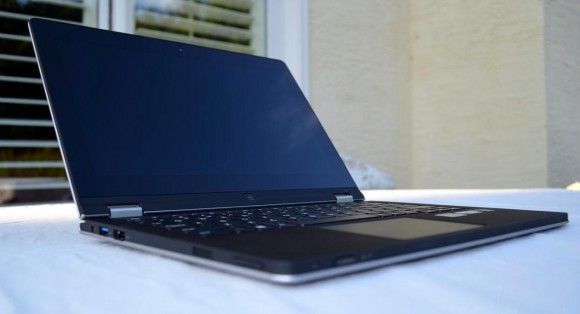
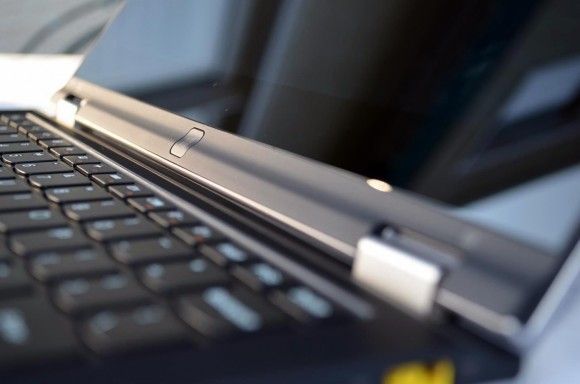
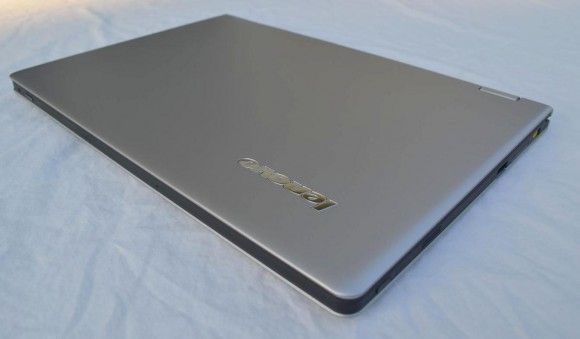
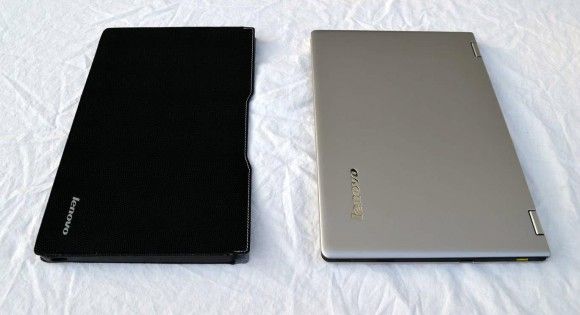











Great review Ben. Let’s hope the price gets even better over the coming months.
For future reviews can you provide the following:
-WiFi chip and antenna configuration.
-Time graphs of WiFi data rate and latency over a long period.
-Time graphs of CPU frequency under prolonged load. If using cTDP then do this for each TDP setting.
Nice review. I guess the keys in tablet mode really are awkward. That close button seems unnecessary to me as well. I’m surprised Lenovo didn’t provide a groove for easier opening of the notebook.
Oh well, didn’t really think the whole yoga concept was good. Looks like it really isn’t that great after all.
This please. This review is even missing any information about WiFi and how much Turbo can be maintained. It’s as if the Yoga doesn’t have WiFi capabilities.
What WiFi configuration(s) does this have? It’s completely missing from the review.
One question: how is the Ivy-Bridge-Y (I7) compared to AMD’s Temash A6 ?
tried the 11S at BestBuy yesterday. i’m not sure if its just the demo i used, but when in tablet mode, keypress are still registered. isnt it suppose to disable the keyboard when in tablet mode?
Yes it’s definitely supposed to disable the keys — worked perfectly on the unit I used.
40% faster in worst case, and 2.5x+ faster in best case in favor of the Ivy Bridge Y. The Ivy Bridge will get 2x or more gains in scenarios that are lightly threaded, which you will find it to be the case in vast majority of usages.
It’s probably worth mentioning that both the Yoga 13 and Yoga 11S uses single-channel memory. That will hamper the CPU performance a bit and GPU performance quite a bit.
What kind of real world FPS drop for a particular game you know of would a single-channel memory have vs dual-channel? Benchmark number differences usually can’t be easily converted to any kind of FPS differences. Sometimes a large benchmark score difference didn’t have much impact on actual FPS.
I don’t know why anyone takes any unit with a 1366×768 display seriously today, or how PC makers keep getting away with marketing inferior products. Seriously, Google can release a $229 quad core tablet with a 1920×1200 display, 2gb ram, 16gb ssd… and yet PC makers keep releasing $700+ notebooks and tablets with 1366×768 displays.
I’m guessing 20-40% depending on games for the single channel versus dual channel. That would get progressively worse on higher resolutions and settings. That was for the HD 3000, a better performer like the HD 4000 would probably end up little bit worse.
Cinebench GL rendering is actually not very sensitive to memory bandwidth, and neither are the 3DMark benches tested here.
Actually that quad core chip is weaker than AMD E-350 chips on the PC. Using 2GB RAM and 16GB SSD will also save on the money. 4GB vs 2GB RAM would be responsible for about $50 of the cost and 16GB “SSD”(actually a very low throughput eMMC controller) another $150 or so. If you go for the Intel Atom or AMD E series chips you’ll save another $150.
-Then add in margins PC makers require, versus Tablet vendors like Google often close to losing money on the hardware so they can sell apps
-PC makers have too many models, so they are disadvantaged on the volume discount
You will see the resolution disparity quickly close in the next few years. Right now the effort to push 1800p and above displays on the premium will trickle down so you’ll get 1080p in cheap Laptops for example.
I know there are differences in performance, etc. etc. but if you can put a screen in excess of 1080p in a budget tablet and still get good battery life then the arguments for 1366×768 displays just don’t hold water.
At this point I think anything larger than an 11.6″ should at least have 1600×900 displays. I like the 11S but its display completely discounts it as an option for my use.
What’s your use case where the lower resolution would noticeably impact your particular task?
For me, I care more about power consumption, brightness, contrast, viewing angles and glare than high PPI especially on a desktop OS where high PPI causes UI issues. Even setting the DPI scaling causes additional problems.
Its a little heavy for an 11″ device, resolution a little low and I don’t like sagging keyboards.
Lenovo, please don’t let your keyboards slide…